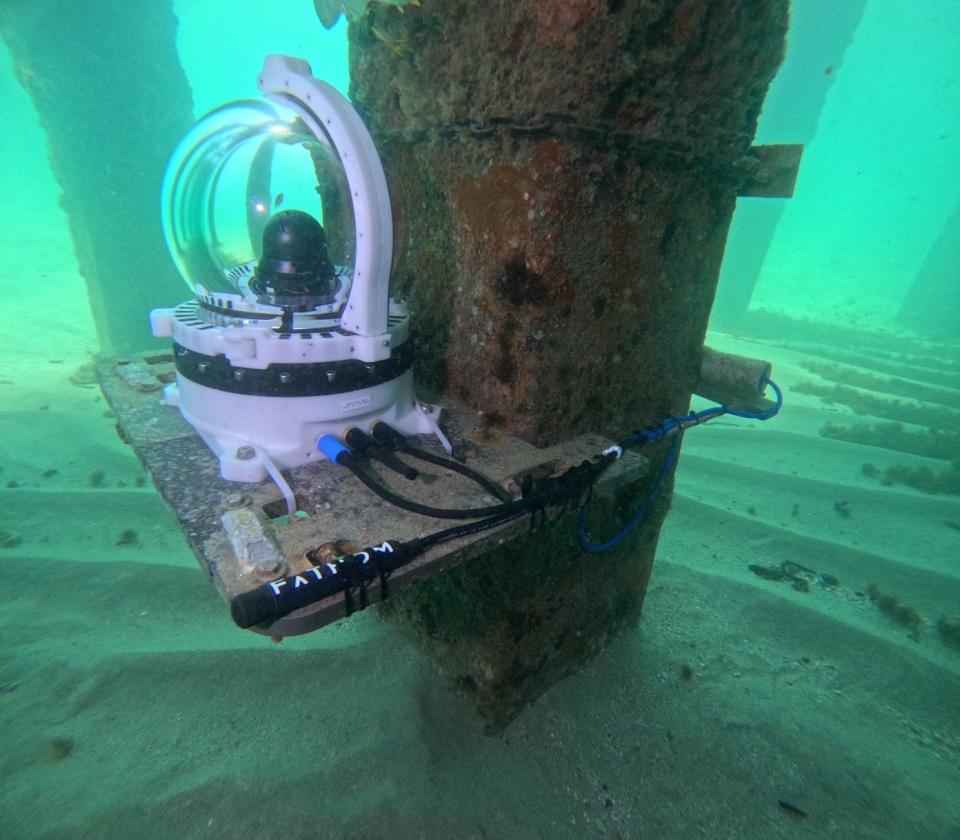The ocean is still largely unexplored. Underwater tech could help illuminate its mysteries.
This article is part of "5G and Connectivity Playbook," a series exploring some of our time's most important tech innovations.
Nestled next to a park and tucked inside an inlet, Wahoo Bay boasts a half-acre of glistening, shallow water in Pompano Beach, Florida, home to tropical fish and endangered seagrass.
But below the surface, the mini marine sanctuary is also a test bed for underwater technology that may take researchers to literal new depths.
Seven years ago, Wahoo Bay started as a vision for a snorkel park, but COVID-19 delayed its development. That delay "was a bit of a silver lining for us because it got us thinking more about creating an educational environment," said Rob Wyre, the chairman of Shipwreck Park, the nonprofit behind the Wahoo Bay project. The Wahoo Bay team was introduced to scientists from different universities who saw the marine area as a place of the right size and depths and with the right protections to assess new underwater technologies.
IoT, or the Internet of Things, refers to a network of connected devices and the technology that allows them to collect and share data. On land, this could look like a home security system sending an alert to your phone or a fitness tracker synced with an app that gives you real-time insights into your health. In the ocean, Underwater IoT could look like floating sensors, swarms of crewless vehicles, or a tetherless, wireless robot. Interest in ocean IoT is increasing because of its potential scientific, military, commercial, and conservation applications.
While only about 5% of the ocean has been explored, experts anticipate that underwater IoT, which can collect and share data from uncharted waters, could expand our understanding of the unknown and unlock the future of ocean conservation.

Underwater IoT can be tricky
Existing wireless technologies aren't much help underwater because of how they work. On land, IoT devices connect through communications technologies like Bluetooth and WiFi that use radio waves at specific frequencies to transfer information. But standard IoT technologies are ineffective in the ocean because radio signals weaken underwater. Ocean IoT often uses a different type of signal to communicate: acoustic signals or waves.
Waleed Akbar, a research assistant at the MIT Media Lab, said that while developing underwater IoT is challenging, it's necessary. "We know more about the far side of the moon than we know about the ocean," Akbar said.
Akbar said underwater IoT could do more than satisfy curiosity about what's below the water's surface. Because these devices can transmit data from unexplored areas, they could enable unprecedented environmental monitoring, such as measuring contaminants or observing coral reefs — providing information that's helpful in curbing the climate crisis.
Using acoustic energy to power new projects
Akbar is part of an MIT research group developing low-cost, low-power, batteryless IoT technologies to support underwater networks.
For example, the group invented a battery-free wireless underwater camera powered by acoustic energy — it converts mechanical energy from sound waves into electrical energy, and it uses sound waves to transmit data. The camera could support marine-life discovery, submarine surveillance, and underwater monitoring, among other endeavors.
"In the water, there's no central entity like a router you can connect to," Akbar said. "So what we have is a base station, and then sensors can communicate with that using acoustic signals."
But acoustic signaling has narrow bandwidth, long delays, and high costs. There's also the issue of energy consumption: Generally, preliminary underwater IoT devices have used batteries with limited capacity. Akbar told Business Insider that it's difficult to scale when technologies consume too much power.
"If you want to make sensors at a large scale, or you want to cover a large area like a chunk of the ocean, you want to make sure that these sensors are cost-effective," he said.
Researchers have been working on underwater acoustic communication technologies for over half a century. For example, in 1945, the US Navy developed an underwater phone that transmitted and received sound waves instead of radio waves.
More recently, scientists and engineers have started to leverage this technology to make underwater IoT a reality. Early projects include autonomous underwater vehicles that can spot ancient shipwrecks, sensors that can help with disaster forecasting, and sensor networks that can measure ocean temperatures.
Today's underwater technology is often hindered by limited battery life and tethers to ships on the surface. Dimitris Pados, a professor at Florida Atlantic University and the director of the Center for Connected Autonomy and Artificial Intelligence, said that to monitor and model the ocean with the granularity necessary to understand how climate change is influencing it, researchers need to access parts of the ocean that existing tech can't reach.
"It's a field that's catching people's attention," Akbar said. "The technology is developing, and there is a growing awareness that we need to know more about what is happening to the ocean."
A hotbed of ocean tech
In late May, Wahoo Bay hosted its inaugural field trip. Fourth graders, equipped with swim masks and pool noodles, splashed above bright-yellow porkfish and silver pinfish. For many, it was their first time snorkeling. Pados said he expects Wahoo Bay will be home to many firsts and innovations.
Through a partnership with Florida Atlantic University, professors, students, and others can bring new underwater technologies to the site — and more projects are in the works.

Pados told BI the team had installed water- and weather-monitoring systems and was working on AI-assisted fish-identification software that relies on a self-cleaning 360-degree underwater camera.
More futuristic tech is in the pipeline, including an underwater GPS and a school of AI robotic fish. "You can imagine that, as long as they can connect with each other, it will be like having a moving network of underwater sensors you can direct to wherever you want," Pados said. "If everything goes well, they'll get outside the bay and into the ocean."
Pados said that while Wahoo Bay is a testing ground, he and his team want to give visitors — whether they're elementary-school students on a field trip or curious Pompano Beach residents on a stroll — a firsthand look at the developing technology.
Wyre said he hopes that when young people see the tech that Pados and his colleagues are working on, they'll walk away with new ideas.
"We've got to support the scientists of tomorrow," Wyre said. "We hope that when students see what's going on in the water of Wahoo Bay, they'll be inspired."
Read the original article on Business Insider


